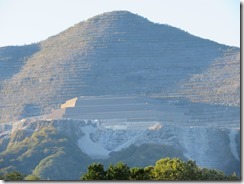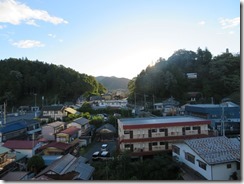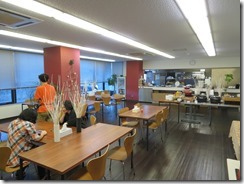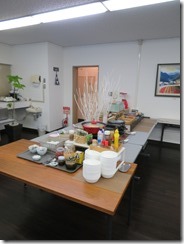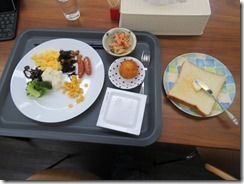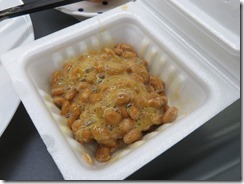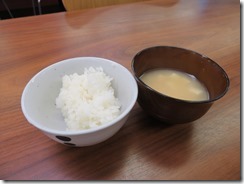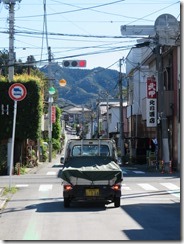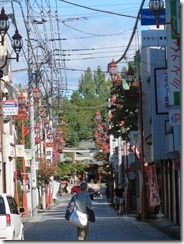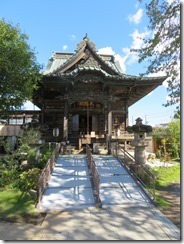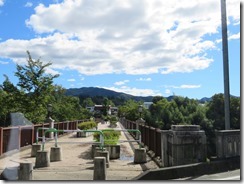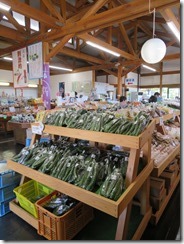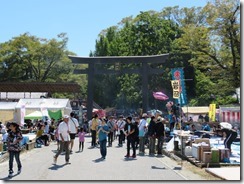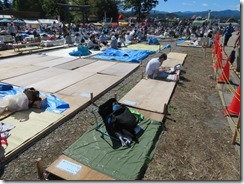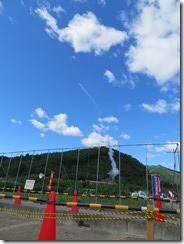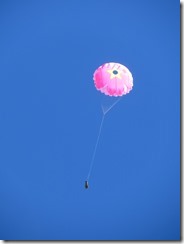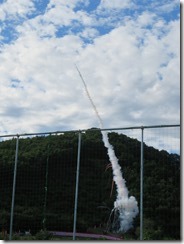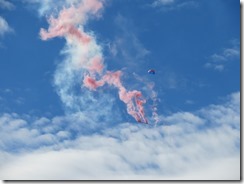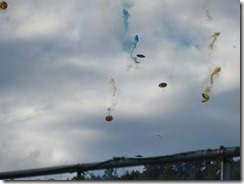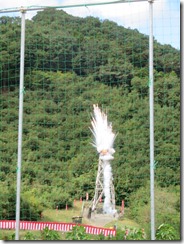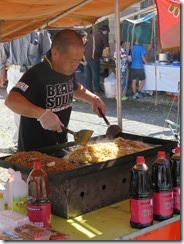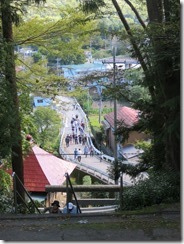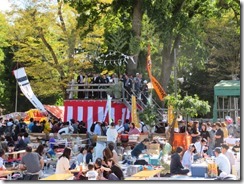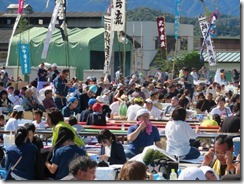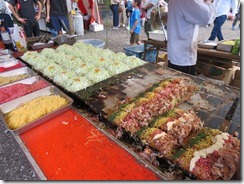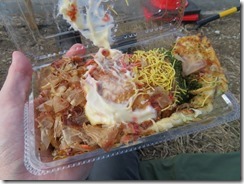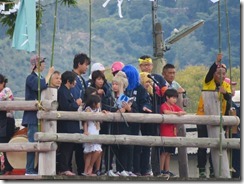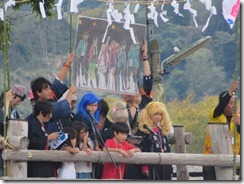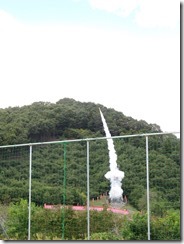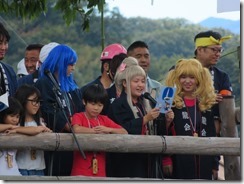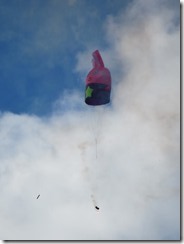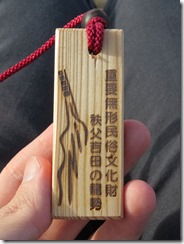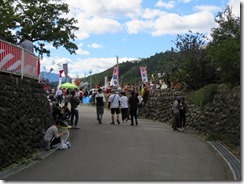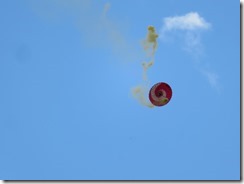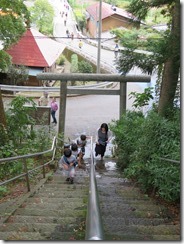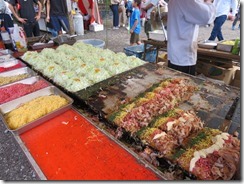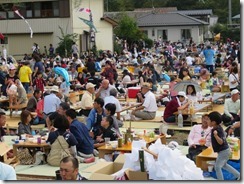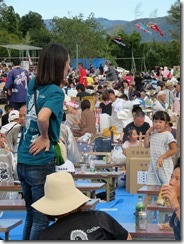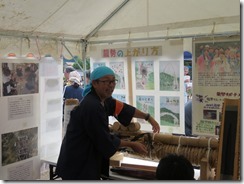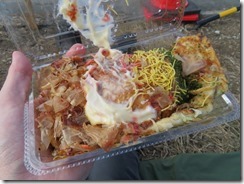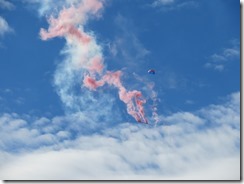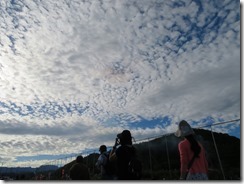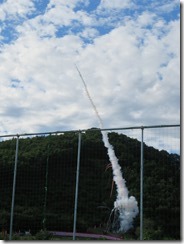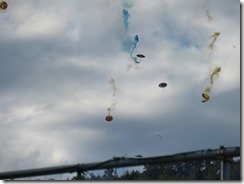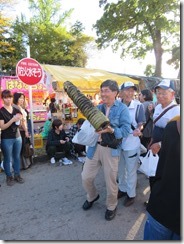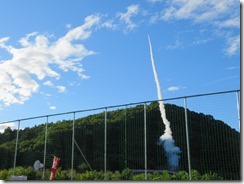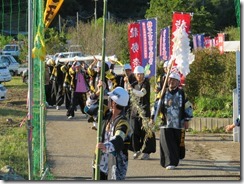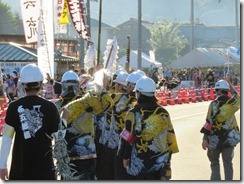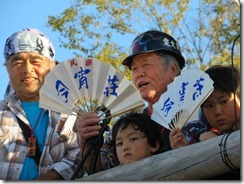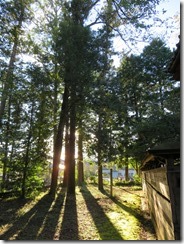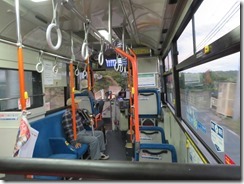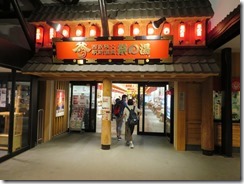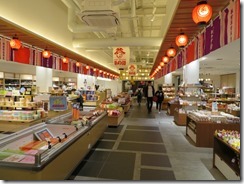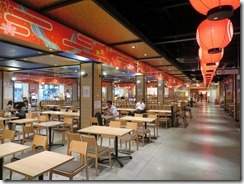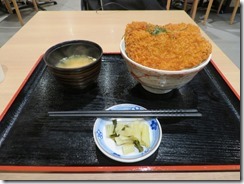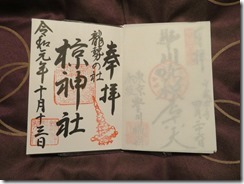I survived Hagibis. Now where’s my t-shirt? Actually, there’s not even a huge amount of visible damage around here, aside from the rivers running pretty high, and dirty.
There’s a band in the Philippines named Hagibis, who’ve been around since the 1970s – they’ve got a style that’s pretty reminiscient of the Village People, and in fact they’re sometimes called the Philippines’ Village People. According to an article in this morning’s Sydney Morning Herald, they’re suddenly seeing a new resurgence in popularity, thanks to Typhoon Hagibis bringing their name to peoples’ minds. They said they’d quite like to do a tour in Japan as a way of making up for some of the hurt caused by their namesake.
Chichibu is a city in Saitama Prefecture. It’s hardly large – it’s only the 35th largest by population in Saitama – but it seems to have quite a significant history. The Japanese Meteorological Agency divides Saitama into six regions, which I noticed while keeping an eye on Hagibis, and these regions are South-East, South-Central, South-West, North-East, North-West, and Chichibu. It’s nestled in a fairly steep mountain range – on a very clear day, they can be seen from central Tokyo – and the Arakawa River runs through the center – which runs to the north, turns right, and comes back down on the eastern edge of Tokyo. Chichibu was first mentioned in written records in the 8th century historical record Kujiki, in which alone out of the 137 provinces mentioned, it’s described with a special note, suggesting that even back then it had some significance.
The area is unsuited to rice growing, but they were quite well-suited to growing mulberry trees, so for a long time the silk industry was the primary source of income for the town – the name Chichibu became synonymous with high-quality plain silk. During the Meiji restoration, the new Meiji government tried to impose rapid industrialisation, causing the silk farmers to rise up in revolt, until the government crushed it, and the town’s silk market has never quite returned to its heyday since. Oh, they’re still famous for a type of silk fabric called meisen, but it’s not quite the same. The town also became a major source for limestone and cement – Mount Buko, to the south of the town, still bears visible scars, and concrete factories pop up all over.
So, woke up with brilliant sun shining through my window – yesterday’s dreary weather had completely passed, leaving blue skies and warm breezes behind. Quite lovely.
Headed down for breakfast in the hotel dining room. Even tried natto again – they had some – but I still found it merely unimpressive, not the strong dislike that foreigners are supposed to feel.
Then I headed out for today’s activity – the Ryusei Festival, held on the second Sunday of October each year at Muku Shrine in Yoshida town (a part of Chichibu city). The name means “dragon power”, and the main part of the festival involves launching rockets – called dragons – which are made from bamboo, pine and black powder by various neighbourhood associations, intended to thank the gods for a good harvest, and wish for more future blessings. Thirty rockets are launched, at fifteen-minute intervals, so it takes all day – while rockets are being set up, members of the group in question stand on a platform, give a speech thanking their patrons (who helped fund the rocket) and then sing/chant a prayer, and the rocket launches as the prayer finishes. Fun fact: Muku Shrine is also the location where the first planning meetings were held during the farmers’ rebellion.
Since the festival runs all day, people bring mats and low tables, and all sit around picnicking and barbecuing food and drinking and generally having fun. I thought I wanted to get in on that action, so I needed to reserve a space by calling them on the phone about five weeks ago – and pay a fee – so the moment I learned of Hagibis, I was very worried they’d be cancelling the festival. Fortunately, they announced on their website on Saturday morning that it’d still be on (albeit with a final call to be made at 6am today, but come 6am, nothing had changed).
So first I headed back to Seibu-Chichibu Station to get the special bus that’d take me straight to the festival – stopping en route at a nearby temple named Jigen-ji, for reasons which I’ll describe tomorrow. Tried not to get too distracted by the streets on the way, but at once point I saw an honour-system roadside vegetable stall, though there weren’t any veggies there at the moment.
At the station, I went to ask at the bus information booth where the special temporary bus stop was… and it wasn’t. Turns out I’d stopped reading the note on the festival website one line too soon – the festival was still on, but the special buses had been cancelled, for reasons that it doesn’t go into. And I’d just missed the last regular bus for the next three hours by mere minutes.
Extremely annoyed by that, and trying not to play a game of coulda, woulda, shoulda (I coulda not stopped at Jigen-ji, I shoulda gotten out of the hotel more promptly) I eventually decided to get a taxi instead – my only other options were to wait three hours for the next bus, or walk, which would take three hours anyway. It cost me 4250 yen. Not happy, Jan.
Well, I arrived, in any case. The taxi dropped me at the Ryusei Kaikan (the festival association hall), where the bus would have stopped. After my little excitement in planning when I discovered that Chichibu has a Michi no Eki quite close to the town centre – a few days before I flew here, I discovered that the Ryusei Kaikan is itself a Michi no Eki too. It’s got a large hall with a produce market, and also a museum of the Ryusei Festival. And also a stamp – as part of the Ryusei Festival, there’s a small stamp rally, and one of the stamps was here.
Stamp got, I strolled to Muku Shrine to find my reserved spot – I’m at the very front of A-block (probably because that’s where all the half-tsubo-sized, intended for one or two people each, areas are located (a tsubo is a standard sized area in Japan equivalent to two tatami mats (so a half-tsubo is one mat area), but what that standard is depends on where in Japan you are)), which gave me a nice view of the rocket tower (albeit slightly obscured by a high temporary fence which I hadn’t realised would be there). My space had a marker with my name written on it, which was quite nice.
I actually wound up buying quite a few things to bring on this trip which I’ll probably only use today on this trip – a low folding chair (because full-size chairs aren’t allowed due to blocking the view of others, and I just plain can’t sit on the floor all day), a groundsheet, an inflatable pillow to use as a cushion – so I set things up and settled in to watch a few rockets. I’d also brought a few Australian snacks to share with the people around me, but despite being marked with names, like mine, all of the reserved spaces nearest me remained empty all day. And also, about half of the snacks were chocolates (caramello koalas and furry friends), and they’d all melted before I realised how warm they were, despite my efforts to keep them shaded.
But anyway, rockets. The rockets are loaded with decorations that are intended to trigger when the rocket reaches the apex of its flight – parachutes, paper umbrellas, smoke bombs, flares or sparklers or secondary explosions. A rocket is considered good if it flights straight and true, and the decorations deploy correctly, but since it’s made of pine and bamboo, honestly anything can happen. Some flew well, some waited juuust long enough to make you think they were going to be duds, before suddenly launching, some jumped up but quickly dropped again, some decorations floated around for ages – one parachute carrying the main body of one group’s rocket even started drifting over the crowd shortly after I arrived.
One rocket even blew up on the tower, and I managed to get a pretty nice photo of it.
The shrine grounds themselves were filled with all manner of festival food and game stalls, and I went to wander through them – yakisoba, okonomiyaki, takoyaki, chicken and beef skewers, tapioca tea, churros, crepes, chocolate-coated bananas, drinks, even one stall selling mango and mandarin in tins (which I’m sure has gotta be a pun – “mandarin” in Japanese is “mikan”, while a tin can is just “kan”, so tinned mandarin is “kan mikan”).
I was going to try a bunch of things, but started with a Hiroshima-style okonomiyaki, which just filled me right up, so that was all I wound up having. Didn’t even have a kan mikan, though I was sorely tempted.
So, I first learnt about this festival because it plays a major part in a 2011 anime I enjoyed named “Ano Hi Mita Hana no Namae o Bokutachi wa Mada Shiranai” (which means “We Still Don’t Know the Name of the Flower We Saw That Day” – usually abbreviated as just “Anohana” (“That Flower”), and officially titled in English as “Anohana: The Flower We Saw That Day”) in which the main characters (who live in Chichibu) learn how to build a ryusei rocket because they believe it’s the final wish of a deceased member of their group. Somehow, watching the series gave me the impression that the festival occurs in summer – it was only midway through my planning that I realised not only does the festival occur in Autumn, it’d be occurring on my second full day in Japan. But in any case, Anohana put Chichibu on the map for a lot of Japan, and ever since it became famous, the festival has always launched one rocket in honour of the series – the speech and chant were given by women dressed as the characters from the series. Also, character images are used in a lot of the advertising, and they were all over the place.
(Side note, Chichibu is on the Anime 88 Pilgrimage twice, once for Anohana, and once for an anime movie by the same writer named “Kokoro ga Sakebitagatterunda” aka “The Heart Wants to Shout” aka “The Anthem of the Heart”. Sadly, neither entry is accompanied by a stamp.)
I managed to finish the Ryusei stamp rally – if I understand the description correctly, they’ll mail us a prize at some point, but I’d be a little bit surprised if they mail it all the way to Australia. The entire day, I saw three other foreigners, in a crowd of literally thousands. Or at least, three Caucasian foreigners. Also, while I was sitting in my space, the woman I spoke to on the phone when I reserved it walked past and saw me – she was quite happy to see me; even gave me a wooden tag on a lanyard (which she was selling) as a present. It reads “Important Intangible Folk Cultural Property: Chichibu Yoshida’s Ryusei” (it’s one of only eleven contests in Japan to be added to the list – many of the others are tug-of-war festivals).
Since I’ve basically covered all the description of today – watching rockets interspersed by wandering around the crowds, here’s some more photos of rockets, interspersed by photos of crowds.
Not planning to take the taxi back to the hotel again, I made a point of checking Google for when the last bus of the evening would be, and so just after the final rocket launched as the sun was setting, I headed for the nearest stop, which Google suggested. Concerningly, I was the only person at the stop – I would have thought at least some people took the bus. When the bus arrived, I hopped on. At which point, the bus headed to the next stop – the Ryusei Kaikan – and that’s where all the people were waiting, filling the bus completely. Good thing I went to the earlier stop – it was even closer to the festival, according to Google maps.
Back at Seibu Chichibu Station, I discovered that Matsuri no Yu – the food hall attached to the station – was open for business, so I decided to head in there for dinner. It’s got three areas – a big hall selling local souvenir snacks, a second big hall basically like an Australian food court (lots of little restaurants selling different foods, and collective tables in the middle for people to eat at), and an actual onsen. Think I might try the onsen tomorrow, perhaps, but for now I had dinner: a local specialty called waraji katsudon. Waraji are straw sandals, which these marinated, breaded and deep-fried pork cutlets (katsu) are figuratively the size of, and served on rice (the –don). Extremely tasty.
Strolled back to the hotel chatting with the family on video chat, as is our weekly custom. When I arrived at the hotel, the desk staff had my room key out all ready for me.
Time for bed. Tragically, rain is predicted to return – hopefully not the same sort of torrential rain we had yesterday, because I really don’t want to cancel my plans again. Or get particularly rained on…
Today’s photo count: seven hundred and fifty-nine. See? Told you I could accomplish much with some sun. Though I’m pretty sure a lot of those photos were taken in drive mode, trying to get the perfect photo of a rocket launching.
Today’s step count: 11,871 steps – 8.3km – 4 flights of stairs
Today’s goshuin count: Two – one at Jigen-ji (which I’ll probably show off tomorrow) and one at Muku Shrine (pictured below)
Today’s stamp count: Aside from the three stamp rally stamps, the Ryusei Kaikan had its own stamp, which I stamped in my book from last trip.

